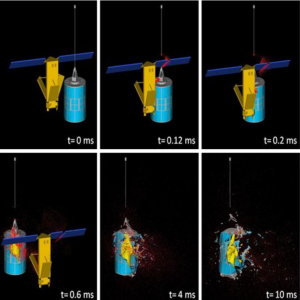Numerical Simulations for Spacecraft Catastrophic Disruption Analysis

At present, the largest part of the catalogued space debris population consists of fragments originating from accidental explosions of spacecraft and upper stages, but it is expected that hypervelocity collisions involving large objects could become the primary source of new debris in the mid-term future. In this context, understanding the physical processes involved in spacecraft collisions is crucial, because these big impacts are one of the key drivers of the long-term evolution of the amount of space debris. In particular, hypervelocity impacts resulting in the fragmentation of very significant parts of the colliding objects and the subsequent production of new debris large enough to cause other critical blows are referred to as 'catastrophic collisions'.It is believed that catastrophic impacts occur when the kinetic energy of the impactor is greater than 40 Joules per unit mass (in grams) of the target (energy-to-mass ratio EMR>40 J/g).
Currently, empirical and semi-empirical breakup models are the most common means to provide detailed descriptions of fragments clouds originatinf from catastrophic collisions. On one hand, the most used empirical breakup tool is the NASA Standard Breakup Model (SBM); however, the actual version of the NASA SBM is not able capture the complexity of the various possible impact scenarios, as they result from latest spacecraft designs, as well as the effects of impact point (e.g. collision on main body vs. collision on appendages). On the other hand, semi-empirical models combine mass, momentum, and energy conservation principles with empirically-derived relationships from laboratory test data and observations of orbital breakups. Semi-empirical approaches are chosen to create simple, fast-running models not requiring very comprehensive inputs; two remarkable examples of semi-empirical breakup models are provided by FAST and IMPACT. Other simulations approaches, e.g. based on the use of finite elements, discrete elements, hydrocodes, or combinations of these techniques, are still in their infancy because of the complexity of the physical problem, the large scales involved, and, most critically, the massive computational effort requested to analyse collisions with large multi-part objects such as entire satellites.
